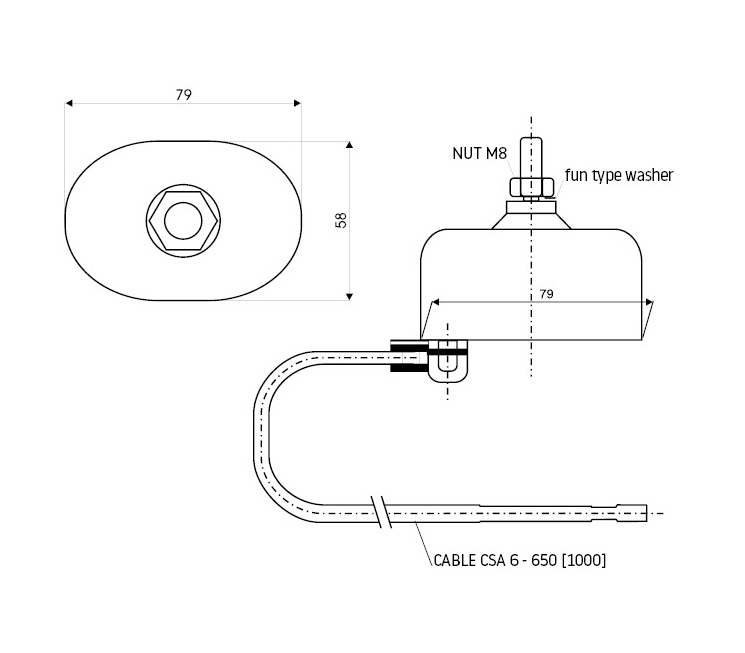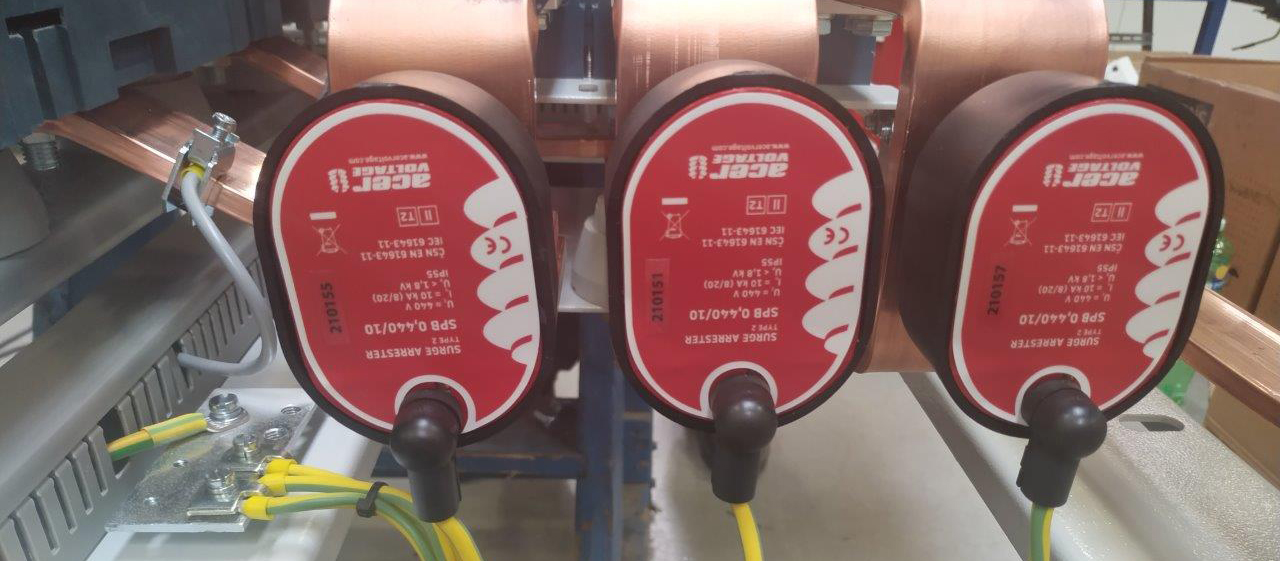Surge arrester SPB */10 PP **
SPB */10 PP **
on flat busbars
SPB */10 PP* - a surge arrester as per EN 61643-11: 2012 with a nominal discharge current of 10 kA and a maximum continuous operating voltage of UC = 280 V, 440 V, 500 V or 660 V. They provide protection against low-voltage overvoltage, they protect in low-voltage overhead power distribution systems, electrical equipment, instruments, switchgears of distribution transformers and reduce the risk of damage to in-house systems and their equipment by atmospheric and switching overvoltage in AC systems with a frequency of 48-62 Hz. The SPB surge arresters protect against the destructive effects of lightning and switching overvoltage. It is recommended to use them in places secured against contact, e.g. by a position or barrier. The SPB surge arresters do not require any special maintenance, only a check after thunderstorms with atmospheric discharges. The destruction of arresters due to great overloading is indicated by the lifting-off of a red signalling cap. Considering the fact that an arrester is not destroyed in the event of its excessive overloading above guaranteed limits and subsequent thermal breakdown. This arrester can be mounted into switchboards directly on the buses of a power circuit-breaker.
| Type | SPB 0,280/10 PP ** | SPB 0,440/10 PP ** | SPB 0,500/10 PP ** | SPB 0,660/10 PP ** | |
|---|---|---|---|---|---|
| Category tested in accordance with EN 61643‑11 | Type 2 | ||||
| Max. continuous operating voltage | UC | 280 V AC 350 V DC |
440 V AC 585 V DC |
500 V AC 670 V DC |
660 V AC 895 V DC |
| Nominal discharge current (8/20) | In | 10 kA | |||
| Max. discharge current (8/20) | Imax | 40 kA | |||
| Voltage protection level at IN | UP | < 1,25 kV | < 1,8 kV | < 2,2 kV | < 2,5 kV |
| Response time | tA | < 25 ns | |||
| Operating temperature range | ‑ 40 °C ÷ + 80 °C | ||||
| Operating position | vertically with max. departure ± 45° | ||||
| Protection type | IP55 | ||||
| Protection | internal thermal disconnector | ||||
| Weight | m | 230 g | 235 g | 250 g | 270 g |
| * : conductor lenght and color | Article number | ||||
| 100gy : 100 cm, green‑yellow | 90176 | 90170 | 90210 | 90216 | |
| 100b : 100 cm, black | 90177 | 90171 | 90211 | 90217 | |
| 80gy : 80 cm, green‑yellow | 90178 | 90172 | 90212 | 90218 | |
| 80b : 80 cm, black | 90179 | 90173 | 90213 | 90219 | |
| 60gy : 65 cm, green‑yellow | 90180 | 90174 | 90214 | 90220 | |
| 65b : 65 cm, black | 90181 | 90175 | 90215 | 90221 | |
SPB */10 PP * - on flat busbars in switchboards with a serrated lock washer and nut
Testing methods and criteria
The test methods and criteria of the SPB surge arrester conform to the requirements of Class A pursuant to VDE 0675, Teil 6 and is in accordance with the requirements of ČSN EN 61643-11, April 2003, Class I: "Low-voltage surge protective devices - Part 11: Surge protective devices connected to low-voltage power systems. Requirements and short-circuit tests". The short-circuit current strength is as per EN 60099-4/A2.
Design and properties
Predominantly capacitative current in the order of hundreds of µA passes through the surge arrester at continuous operating voltage. The active component of the current is negligible. When the terminal voltage of the surge arrester increases, the surge arrester changes smoothly to an on-state and limits all types of overvoltage. The response time is very small (in the order of 100 ns) so the surge arrester reliably limits even steep surges of atmospheric overvoltage. The surge arrester consists of a plastic housing with connecting leads, a separately enclosed watertight and electrically isolated varistor encapsulated in silicon caoutchouk, thermal disconnector and a signalling cap in the bottom part of the housing. Easy assembly is an advantage as well. The plastic of the housing is resistant to UV radiation, weather effects and is flame-retardant - Class V0. The connecting screws and terminals are made of stainless steel. The surge arrester is fitted with an earthing cable with an end - green-yellow or black in colour as required by the customer, with a length of 0.65 m, 0.8 m or 1.0 m, or with other lengths as agreed with the customer. The built-in disconnector is used to disconnect the limiter from the mains in the event of its overloading, which may occur owing to the limit parameters of the varistor being exceeded (absorption of greater energy, e.g. due to a long-term increase in the operating voltage above Uc, or due to great voltage induced by a lightning strike in the immediate vicinity). The maximum current of the varistor is 100 kA, 4/10 μs. In the event of two consecutive pulses of 65 kA, 4/10 μs, the varistor temperature may reach a value at which the disconnector gets disconnected.. Disconnection is signalled in such a way that the red cap of the surge arrester in the bottom part of the housing is lifted off. In the event of varistor breakdown (e.g. when the maximum current is exceeded owing to a steep pulse), the enclosed varistor may be carried up from the housing by short-circuit current without the outer shell of the surge arrester being damaged or destroyed. This will ensure that the surge arrester is disconnected from the mains without potential damage to surrounding objects (except the bottom part) or a flashover between busbars in the switchgear. The disconnection is again indicated by the lifting off of the cap. When an insulated terminal is used, all the live parts remain sufficiently insulated and protected against accidental contact.
Transport, handling and storage requirements
The surge arresters shall be packed individually in a polyethylene bag and transported in non-returnable cardboard boxes. Other packaging is possible by agreement with the customer.
The surge arresters shall be stored in cartons in indoor closed stores at a temperature from -30oC to +30oC. Foam or water may be used as extinguishing agents.
During transport it is necessary to handle the product with care so as not to damage the carton packaging.
Effect on the environment
There is no risk of a negative influence on the environment during the transport, handling, storage and use of the product. The disposal of da





